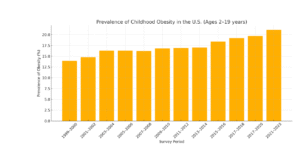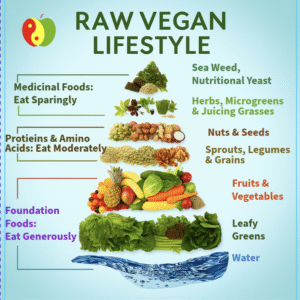World Still Failing Our Kids on Obesity, and Is There a Radical Way Out?
Hello, fellow citizens, parents, and anyone who gives a damn about the future of our children!
I just finished Michelle Obama’s incredible memoir, ‘Becoming,’ and while her journey is inspiring, one thing hit me like a ton of bricks, a recurring, heartbreaking theme she dedicated her life as First Lady to: childhood obesity in America.

She launched “Let’s Move!”, a monumental effort to get our kids healthier. She wrestled with food companies, changed school lunch menus, got kids moving, and put the White House Kitchen Garden on the map. She did everything right, with grace, intelligence, and relentless dedication.
And here’s the brutal, inconvenient truth: We are still failing.
The Numbers Don’t Lie: A Generation at Risk

Prevalence of Childhood Obesity in the U.S. (Ages 2-19 years)
- 1999–2000: 13.9%
- 2001–2002: 14.8%
- 2003–2004: 16.3%
- 2005–2006: 16.3%
- 2007–2008: 16.2%
- 2009–2010: 16.8%
- 2011–2012: 16.9% (This is the “Let’s Move!” era, folks – a slight slowdown, but not a reversal!)
- 2013–2014: 17.0%
- 2015–2016: 18.4%
- 2017–2018: 19.2%
- 2017–2020: 19.7%
- 2021-2023: 21.1%
Let that sink in. Despite the incredible “Let’s Move!” campaign, despite all the smart people and vast resources in this “resourceful country” (as I’ve been reflecting), we’ve gone from roughly 1 in 7 kids being obese to over 1 in 5 kids. In just two decades.
This isn’t just about weight; it’s about type 2 diabetes appearing in elementary school, about joint pain in teenagers, about bullying, low self-esteem, and a future plagued by heart disease and countless other preventable illnesses.
Why the Hell Are We Failing?
This is where the “blunt” part really kicks in. It’s not because we’re stupid. It’s not because we don’t care. It’s because we’ve built a society that actively works against our health, and we, collectively, enable it.

- The “Obesogenic” Environment: We Are Drowning in Bad Food.
- Processed Poison: Our grocery store aisles are monuments to cheap, convenient, hyper-palatable “food products” engineered to hook us on sugar, salt, and unhealthy fats. They’re cheaper, they last forever, and they’re everywhere.
- Marketing Mayhem: Our kids are bombarded from every angle – TV, TikTok, YouTube, video games – with slick ads for sugary cereals, fast food, and candy. It’s predatory, and we let it happen.
- Food Deserts are Real: In too many communities, especially lower-income ones, a bag of chips is easier to find than a fresh apple. This isn’t an accident; it’s a systemic failure of access.
- The Sedentary Trap: We’ve Engineered Movement Out of Life.
- Screen Time Epidemic: Our kids are glued to screens. Period. Hours spent on devices replace hours running, jumping, and playing.
- PE Cuts and Recess Robbed: Schools, under pressure, often slash physical education and recess. We prioritize test scores over healthy bodies.
- Unsafe Neighborhoods & No Play Spaces: For many, playing outside isn’t an option due to safety concerns or simply a lack of parks and sidewalks. We drive everywhere.
- Powerful Pockets Over Public Health:
- Lobbying Power: The food and beverage giants spend astronomical amounts of money to ensure regulations that protect their profits, not our health.
- Short-Term Thinking: Our political cycles are short. Long-term public health investments get sidelined for quick fixes and headline-grabbing measures.
- Our “Freedom” to Choose Sickness: We fiercely protect individual “choice,” even when that choice is heavily influenced by manipulative marketing and an environment designed to make us sick. We resist anything that feels like a “nanny state,” even if it could save lives.
- The Intergenerational Curse: We’re Handing Down Our Habits.
- If we, as adults, are exhausted, stressed, and living on processed foods and screens, our children will learn those behaviors. This isn’t about blaming parents; it’s about acknowledging the cycle. We are, unintentionally, setting up the next generation for the same struggles, but worse, because the starting line is further back.
It is, frankly, a shame. A colossal, heartbreaking shame for a country as intelligent and resource-rich as the United States. We know the problem, we know many of the solutions, yet the needle keeps creeping up.
The Radical Thought: Is a Plant-Based Raw Food LIFESTYLE the “Simple” Answer We’re Afraid To Embrace?
Okay, so if the conventional, incremental changes aren’t turning the tide, what about something more radical? Something that rips us out of the processed food matrix entirely?
I’ve been thinking, perhaps the solution isn’t about dieting or restrictive meal plans, but a complete lifestyle shift to a plant-based raw food approach.
Hear me out before you dismiss it as “extreme.”
Imagine a world where our children’s plates are overflowing with:
- Vibrant, fresh fruits: Nature’s candy, bursting with nutrients and natural sweetness.
- Crisp, colorful vegetables: The true powerhouses of vitamins and minerals.
- Crunchy nuts and seeds: Healthy fats, proteins, and fiber in every bite.
- Sprouted grains and legumes: Living foods, easy to digest and packed with energy.
Why this isn’t just a “diet,” but a LIFESTYLE SOLUTION:
- Eliminates the Enemy: By focusing on raw, whole plants, you automatically cut out the vast majority of processed junk, added sugars, unhealthy oils, and artificial ingredients that are poisoning our kids. No more debates about “healthy snacks” when the snacks are literally just fruit.
- Nutrient Powerhouse: Kids would be flooded with the micronutrients, fiber, and enzymes their growing bodies desperately need, but are largely missing from standard American diets.
- Natural Weight Regulation: When you eat foods low in calorie density but high in nutrients and fiber, it’s incredibly difficult to overeat. Kids would feel full, energetic, and naturally gravitate towards a healthy weight.
- Resets the Palate: By removing the overwhelming sweetness and saltiness of processed foods, children’s taste buds would re-learn to appreciate the subtle, natural flavors of real food.
- Empowerment through Simplicity: Yes, it requires preparation. But it simplifies choices dramatically. No more endless labels to read. No more wondering what hidden ingredients lurk. Food becomes pure.
- Direct Connection to Nature: This lifestyle encourages a deeper connection to where food comes from, fostering an appreciation for healthy, natural ingredients.
The Blunt Truth About Its “Difficulty”:
I know what you’re thinking: “But it’s too hard! What about protein? What about B12? What about birthday parties?”
And yes, it presents challenges:
- Logistics: It requires planning, shopping for fresh produce, and time for preparation.
- Nutrition Nuance: You need to educate yourself on how to get all necessary nutrients (especially B12, Vitamin D, calcium, iron, omega-3s) from plants and consider supplements. This is where education and resources are key, not an excuse to avoid it.
- Social Pressure: It’s different. Kids might feel left out. Parents might face judgment. But isn’t our children’s health worth being “different”?
But here’s my blunt counter-argument:
Is it harder than watching your child develop type 2 diabetes at age 10? Is it harder than the lifelong struggle with obesity, self-esteem issues, and chronic illness? Is it harder than the immense emotional and financial cost of treating preventable diseases for decades?
No. It’s not.
We have intelligence. We have the resources. We have a scientific understanding of nutrition. What we seem to lack is the collective will, the radical courage, to fundamentally change the game.
Michelle Obama started the conversation. She made massive strides within the system. But perhaps it’s time for us, the public, to look beyond incremental changes and ask if a truly radical shift in our approach to food – specifically a deep embrace of a plant-based raw food lifestyle – is the bold, simple, and desperately needed solution to stop ruining the next generation.
Let’s discuss. Your thoughts?
–Axay Shah
Raw Food Guru
RawFoodiest.com

